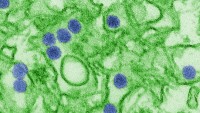Dinosaur that Once Roamed China Wore Camouflage to Protect Itself
| Arthur Dominic Villasanta | | Sep 17, 2016 10:46 PM EDT |
(Photo : Jakob Vinther, University of Bristol and Bob Nicholls) Psittacosaurus is the first dinosaur to show evidence of countershading.
The almost complete fossilized specimen of a dinosaur found in China has led scientists to surmise this one wore camouflage colors to escape larger predators.
The small but colored "Psittacosaurus" is the first dinosaur that shows evidence of "countershading," a type of camouflage where animals have darker-colored backs and lighter bellies. This particular specimen is believed to have had a brown back and a lighter colored belly.
Like Us on Facebook
Scientists believe this specimen was probably countershaded due to its preferring a habitat in dense forests with little light to create disruptive coloration. Psittacosaurus have stubby spikes on its cheeks and a beaked jaw. A mass of quills sprouted along its tail.
This countershading can be seen in modern species of forest-dwelling deer and antelope whose stripes and spots on their limbs create disruptive coloration. Giraffes are also good examples of countershading.
Psittacosaurus ("parrot lizard") is a genus of extinct ceratopsian dinosaur from the Early Cretaceous of what is now Asia, existing between 123.2 and 100 million years ago. It is notable for being the most species-rich dinosaur genus.
Up to 11 species are known from across Mongolia, Siberia, China and possibly Thailand. The species of Psittacosaurus vary in size but its length ranged from less than two to over three meters.
"This one is unique," said paleontologist Jakob Vinther of Britain's University of Bristol, co-author of a study describing the fossil published in the journal Current Biology.
"We can very clearly see that there are color patterns ... stripes, spots."
Psittacosaurus's dark back and lighter belly are visible on the specimen's remaining scales. Scientists said today's predators rely on an object's shading to assess its shape.
When prey is darker on top than on the bottom, a color scheme known as countershading, shadows are minimized and the animals look flatter.
TagsPsittacosaurus, countershading, parrot lizard, china, Jakob Vinther
©2015 Chinatopix All rights reserved. Do not reproduce without permission
EDITOR'S PICKS
-

Did the Trump administration just announce plans for a trade war with ‘hostile’ China and Russia?
-

US Senate passes Taiwan travel bill slammed by China
-

As Yan Sihong’s family grieves, here are other Chinese students who went missing abroad. Some have never been found
-

Beijing blasts Western critics who ‘smear China’ with the term sharp power
-

China Envoy Seeks to Defuse Tensions With U.S. as a Trade War Brews
-

Singapore's Deputy PM Provides Bitcoin Vote of Confidence Amid China's Blanket Bans
-

China warns investors over risks in overseas virtual currency trading
-

Chinese government most trustworthy: survey
-

Kashima Antlers On Course For Back-To-Back Titles
MOST POPULAR
LATEST NEWS
Zhou Yongkang: China's Former Security Chief Sentenced to Life in Prison

China's former Chief of the Ministry of Public Security, Zhou Yongkang, has been given a life sentence after he was found guilty of abusing his office, bribery and deliberately ... Full Article
TRENDING STORY

China Pork Prices Expected to Stabilize As The Supplies Recover

Elephone P9000 Smartphone is now on Sale on Amazon India

There's a Big Chance Cliffhangers Won't Still Be Resolved When Grey's Anatomy Season 13 Returns

Supreme Court Ruled on Samsung vs Apple Dispute for Patent Infringement

Microsoft Surface Pro 5 Rumors and Release Date: What is the Latest?













